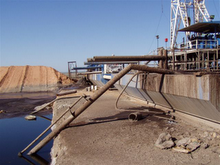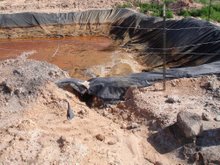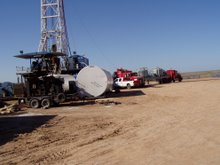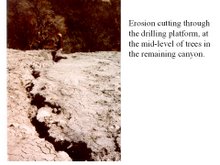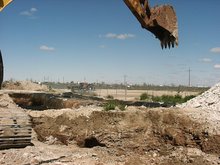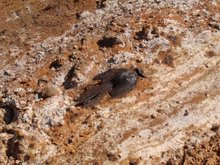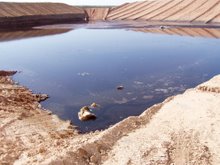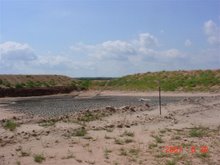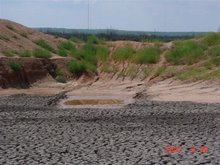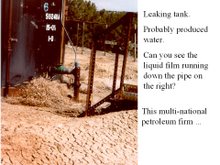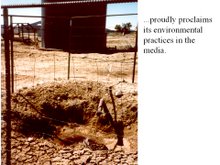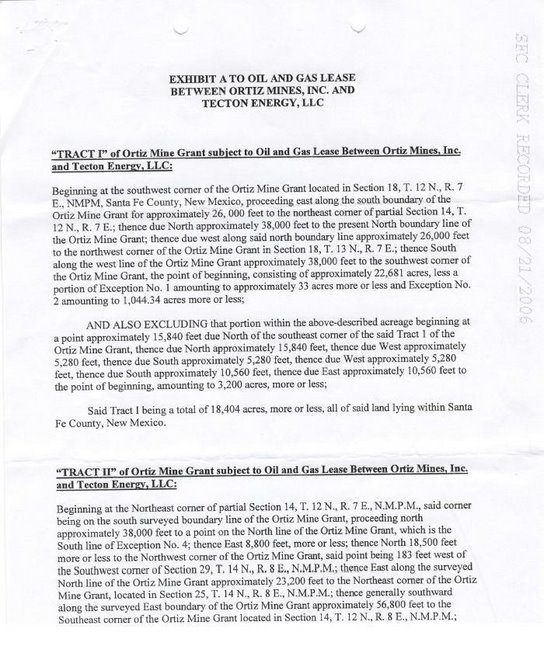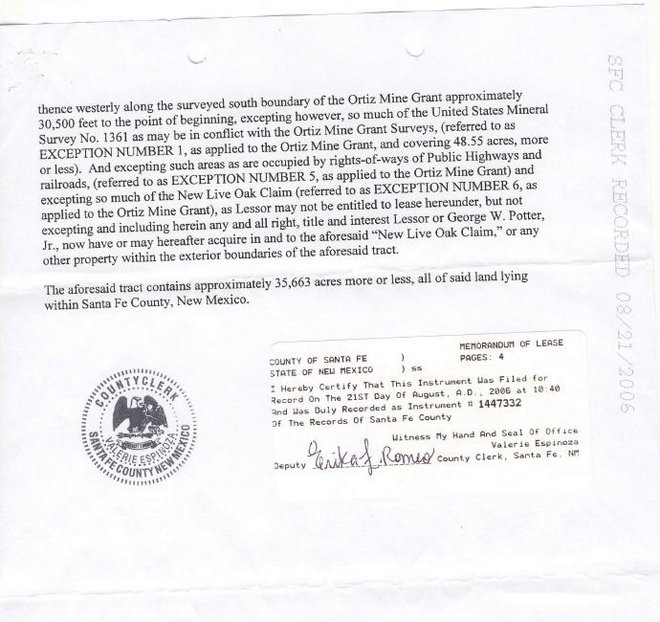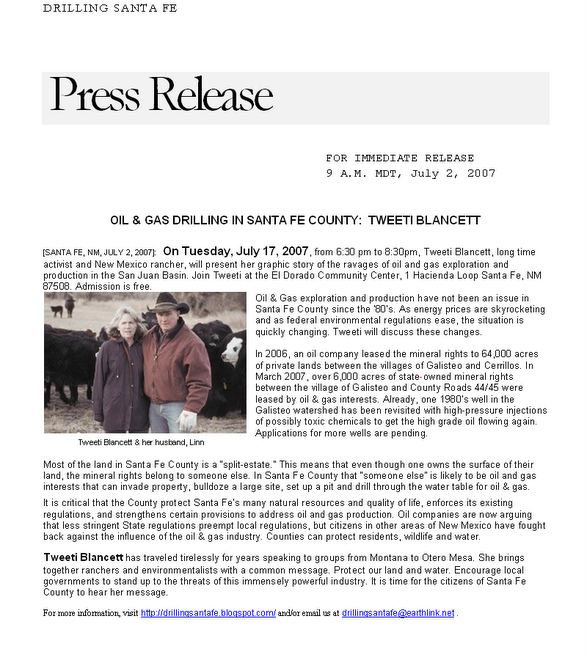Please watch for email alerts about these and other bills. For tracking of these bills, please go to Common Ground United, Roundhouse 2009.
Saturday, January 31, 2009
Senate Bill 17 versus House Bill 471
Please watch for email alerts about these and other bills. For tracking of these bills, please go to Common Ground United, Roundhouse 2009.
Wednesday, January 28, 2009
Bill on Drilling Rules Stirs Debate
Wednesday, January 28, 2009
By Raam Wong
Journal Staff Writer
"Santa Fe County and other local governments would most likely be barred from regulating oil and gas operations under a measure before the state Legislature.
The bill would put regulatory authority solely in the hands of the state Oil Conservation Division. But critics and even OCD officials say the division doesn't now have the authority to address local concerns, ranging from zoning to noise.
“Our regulatory authority is fairly limited,” OCD spokeswoman Jodi McGinnis Porter said Tuesday.
If enacted, the legislation would put to rest a debate over whether local governments can impose rules on the industry.
The Santa Fe County Commission did just that last month in approving one of the nation's toughest drilling laws. The move came in response to an industry proposal to explore in the Galisteo Basin southeast of town.
The ordinance — which addresses many issues not governed by the state's Oil and Gas Act — was opposed by industry officials who said the county was overreaching. And the New Mexico Oil and Gas Association has threatened to challenge the ordinance in court, saying regulation is the responsibility of the OCD, not local government.
Senate Bill 17 was introduced by Republican state Sen. Carroll Leavell of Hobbs, who did not return a call for comment Tuesday." More (subscription required)>>>>>
Firms aim to tap area's deep water
Five wells in works as Legislature considers bill giving state authority over drilling
Staci Matlock | The New Mexican
1/27/2009 - 1/28/09
"Private interests are rushing to tap lightly regulated supplies of briny water deep under New Mexico before the state can adopt new laws aimed at gaining more control over the valuable commodity.
On Monday, five companies with undisclosed ownership notified the state engineer that they intend to drill deep wells in the Santa Fe area and pump out up to 24 billion gallons a year.
They are among various companies that in the past year have been preparing to exploit a rare, unappropriated water supply that underlies the Rio Grande Valley before the New Mexico Legislature considers a bill that could give the state engineer authority over deep wells.
The House Agriculture Committee on Tuesday recommended passage of House Bill 19, sponsored by Rep. Mimi Stewart, D-Albuquerque. However, the bill's fate is uncertain.
While the state engineer is charged with managing New Mexico's water, state law contains an exception — wells that tap into aquifers that start at least 2,500 feet below the land's surface, contain briny water and are disconnected from upper aquifers.
Until recently, only oil and gas companies generally drilled that deep, and they were overseen by the state Energy, Minerals and Natural Resources Department. But the steep cost of treating the salt-laden, deep-aquifer waters has become less of a disincentive to developers and cities as the value of water has risen with semi-arid New Mexico's population growth.
In the last year, 18 companies have notified the state of plans to drill 190 deep wells and pump up to 345,000-acre feet of water per year. (One acre foot equals 325,851 gallons.)
Among those would-be well drillers are the five limited-liability companies that filed their notices Monday.
The companies, which records show were all formed on the same day last February, are all represented by attorney Michelle Henrie of the Albuquerque firm Atkinson & Thal. The company names are listed as San Juan Peaks, El Dorado Mines, Phoenix & Avriel, Monument Valley and Harmony Wells (and the Ortiz Mine Grant, Galisteo Basin, Santa Fe County)." More>>>>
Tuesday, January 27, 2009
SANTA FE COUNTY BOARD PASSES MINING REFORM RESOLUTION
Santa Fe County Press Release:
Santa Fe – January 27, 2008 – Santa Fe County Commissioners Virginia Vigil and Harry Montoya co-sponsored a resolution aimed at reforming the 1872 Mining Law today. “As a supporter of mining, I strongly believe this resolution strengthens the credibility of mining,” said Commissioner Vigil, “It clarifies and improves the process and gives strong consideration to the protection of the environment, local customs, and the economy.”
Reform measures would focus on preserving clean water, wildlife, and public lands as a foundation for local economic prosperity. Tens of thousands of abandoned mines across the western United States are leaking poisons into waterways. The EPA has designated dozens of mines as Superfund sites where water pollution poses an imminent threat to human health and wildlife; the cost of cleaning up thousands of abandoned mines across the western United States is estimated at up to $72 billion dollars.
“Water Resources in New Mexico are sacred,” said Commissioner Montoya “We must preserve our public lands, this resolution addresses protection of sacred places on tribal lands as well as protection of our water resources and watersheds, we must preserve our public lands.”
The 1872 Mining Law, passed shortly after the Civil War and still in effect today, elevates mining as the highest and greatest use of public lands. A new law is needed that protects clean water, restores common sense to land management decisions involving mining, works in conjunction with current state and federal regulations to support protection of the environment, and local culture.
The Board of County Commissioners unanimously passed the resolution today. The resolution supports comprehensive federal mining law reform that: (i) establishes commonsense standards to protect clean water; (ii) ends the selling off (patenting) of public lands for mining in perpetuity; (iii) holds mining companies responsible for restoration and reclamation; (iv) restores balance to public lands management; (v) explicitly gives land managers, with input from local communities, authority to deny mines that cause undue threats to clean water and other values; (vi) provides financial resources for the cleanup of abandoned mines; and (vii) protects highly valued public lands, including wild and scenic rivers, roadless national forests, Native American sacred places and wilderness-quality lands, from large-scale industrial mining.
Santa Fe County postpones hearing again
"On today's midday report: *** Fast developments at the Round House and at the Santa Fe County Commission offices. The State Senate has canceled a meeting on a proposal that would strip counties of any ability to regulate oil and gas drilling. And the county has postponed once again a public hearing on a moratorium on major development. *** Meanwhile, is a huge development already in motion in the county dead or alive? We'll learn more about that proposed movie studio. *** And Sen. Jeff Bingaman gets into the fray over the federal economic stimulus plan. *** Plus more on webcasting at the state legislature." Podcasts>>>>
Sunday, January 25, 2009
County seeks 'visions' of the future
Public meetings aim to help shape revision of growth-management plan
Phaedra Haywood | The New Mexican
1/24/2009 - 1/24/09
Santa Fe County is conducting a sweeping revision of its growth-management and land-use code. Plans made now will affect decisions made by the county for the next two decades.
As a first step in the process, Santa Fe County is asking residents to help paint a picture of what they want Santa Fe to look like in the future.
"What we want to know, is how do you view yourselves?" said Santa Fe County Land Use Director Jack Kolkmeyer.
To this end, county planners have divided the county into four "growth-management" areas. They'll conduct public meetings in each of the four areas over the next few months to allow residents to discuss their visions for the future.
The county's general plan was last revised in 1999. County staff members have been working toward updating it for the past four years. But the process is about to be accelerated because Santa Fe County has decided to hire land-use attorney Robert Freilich and the Planning Works firm — who also wrote the new oil-and-gas regulations — to finish the job.
"We have a real expert on our team now," Kolkmeyer said.
According to county spokesman Stephen Ulibarri, Freilich's approach to planning for growth is more "holistic" than what has been done in the past.
"What happened before was planning had been done almost by accident, piecemeal," Ulibarri said. "A developer would come in and propose a development, and we'd go in and write an ordinance to deal with that type of development. We were being reactive, and we don't want to be reactive. We want to be able to be strategic in the way we plan for growth."
One of the tools used in writing the oil-and-gas regulations that will be used in updating the land-use codes is suitability maps. " More>>>>
Meetings:
EL NORTE
Santa Fe County from the Rio Arriba County line to just north of Tesuque as been designated as El Norte. Meetings to gather public input in this area will be held at the County's Pojoaque Satellite Office, 17839A U.S. 84/285:
Feb. 2: Kickoff, 6 to 8 p.m.
Feb. 3: Open house, 9 a.m. to 12:30 p.m. and 2 to 5 p.m.
Feb. 4: Workshop, 6 to 8 p.m.
Issues of interest in the El Norte area include:
• Water and wastewater systems
• Relationships with Española and the pueblos
• Fire protection
• Transportation
• Economic development
• Housing
EL CENTRO
Santa Fe County south from Tesuque to just south of La Cienega, including the city of Santa Fe and Rancho Viejo, has been designated as the El Centro area. Meetings to gather public input in this area will be held in the Jemez Room at Santa Fe Community College, 6401 Richards Ave.
Feb. 9: Kickoff, 6 to 8 p.m.
Feb. 10: Open house, 9 a.m. to 12:30 p.m. and 2 to 5 p.m.
Feb. 11: Workshop, 6 to 8 p.m.
Issues of interest in the El Centro area include:
• Annexation, relations with the city of Santa Fe.
• Transportation
• Economic development
• Film studios
• The Downs at Santa Fe
• Road connections
• Water and wastewater
GALISTEO
Santa Fe County south of La Cienega — including Eldorado, Cañoncito, Cerrillos, Lamy, Galisteo and Golden — has been designated the Galisteo area. Meetings to gather public in put in this area will be held at the Galisteo Community Center, 35 Avenida Vieja.
Feb. 23: Kickoff, 6 to 8 p.m.
Feb. 24: Open house, 9 a.m. to 12:30 p.m. and 2 to 5 p.m.
Feb. 25: Workshop, 6 to 8 p.m.
Issues of interest in the Galisteo area include:
• Ranching
• Mining
• Traditional communities
• Home businesses
• Eco-tourism
• Road connections
• Water and wastewater
ESTANCIA
The southern tip of Santa Fe County — including Cedar Grove, Stanley, White Lakes and Edgewood — has been designated as the Estancia area. Meetings to gather public input in this area will be held at the Edgewood Senior Center.
March 2: Kickoff, 6 to 8 p.m.
March 3: Open house, 9 a.m. to 12:30 p.m. and 2 to 5 p.m.
March 4: Workshop, 6 to 8 p.m.
Issues on interest in the Estancia area include:
• Clarifying the Edgewood boundary
• Planning for the arrival of a racetrack in Moriarity
• Preservation of agricultural land
• Potential growth
Friday, January 23, 2009
KSFR Mary-Charlotte Interview regarding the Galisteo Basin Photography Project
"Linda Spier Producer of the Galisteo Basin Photoraphy Project Endangered Culture Johnny Micou co-founder of Drilling Santa Fe and Executive Director of Common Ground United."
KSFR Representative Brian Egolf Interview
"State lawmakers take up again on Monday after a Friday recess. And things are moving fast. The newly elected state representative from Santa Fe, Brian Egolf, has introduced a bill that could take some of the surprise out of an oil or gas developer showing up, ready to drill on someone's property." Link to the audio of the interview>>>>>
Faraway, so close

Santa Fe New Mexican / Pasatiempo
Frank Clifford |
1/22/2009 - 1/23/09
The exhibition is also an expression of the vigorous opposition of many Northern New Mexicans to the plans of a Houston-based energy company to drill for oil and gas in the basin. The concern is that drilling could turn much of the area into an industrial wasteland, marring the beauty of the basin, imperiling its extensive archaeological sites, and degrading the quality of its air and water. In the words of its organizers, the Galisteo Basin Photography Project's mission "is to raise public awareness of what will be irretrievably lost if the basin is allowed to become an oil and gas production field." A portion of the proceeds from the sale of the photographs will be donated to local nonprofit groups that have led the fight against the drilling project.
Art in the service of any cause is a risky enterprise. This exhibition, however, avoids the pitfalls. It informs without lecturing, maybe because the photographers had their own reasons for taking pictures of the basin. Many of them live or own property in the area. It's their habitat. Jewelry maker Douglas Magnus documented the views from the abandoned turquoise mine he bought 20 years ago. Walter Nelson photographed countryside he once covered on horseback, following the route of Coronado's 1540 expedition.
Curated by Photo-eye's director, Rixon Reed, and Mary Anne Redding, curator of photography at the Palace of the Governors, the exhibition is a collection of private perspectives: eccentric, whimsical, abstract, and occasionally mysterious. Without always telling you where you are, the images make you glad to be there. "Joyeria," reads the fading storefront sign on a disheveled adobe photographed by Tony Bonanno. " More>>>>
details
Endangered Culture: The Galisteo Basin Photography Project
Opening reception 5-7 p.m. Friday, Jan. 23; exhibit through March 7
Photo-eye Gallery, 376 Garcia St., 988-5159
Additional photographs may be viewed at galisteobasinphotoproject.com
Linda Spier, Producer of the Galisteo Photography Project, letter>>>>>
Roundhouse 2009
Sunday, January 18, 2009
Crank it up!
Less money, mo’ problems: welcome to the 2009 legislature.
By: Dave Maass 01/14/2009
"ENERGY: KILLING DRILLING
The issues: In 2008, environmental and NIMBY anti-drilling activists in north-central New Mexico scored major victories against oil, in many cases fully impeding even exploration. County governments in Santa Fe, Rio Arriba and Mora counties passed moratoria on new oil wells. Meanwhile, the New Mexico Energy, Minerals and Natural Resources Departments’ Oil Conservation Division passed some of the strictest (and most costly) regulations in the country for drilling-operation waste pits.
In the 2009 session, it’s the oil industry’s turn to push back. The New Mexico Oil & Gas Accountability Project is telling activists to prepare to play defense. Deregulation is almost certainly on the agenda.
The politics: Already, Sen. Carroll H Leavell, R-Eddy, has introduced SB 17, a bill that would negate all local government authority over drilling operations and make it the sole responsibility of the state’s Oil Conservation Division. That would mean that what’s good for oil-friendly Farmington would also hold for oil-hypersensitive Santa Fe. Combine that with a budget measure similar to last session’s, when oil interests attempted to gut the Oil Conservation Division’s budget, and suddenly there’s no real oversight. “The idea that we have somehow over-regulated natural resources, oil and gas in particular, and we need to pull back from that regulation—I think that’s the wrong approach,” Wirth, who served on the House Energy & Natural Resources Committee, says. “I think what we’ve seen on Wall Street is an example of what happens when you don’t have balanced regulation and oversight.”
“The idea that we have somehow over-regulated natural resources, oil and gas in particular, and we need to pull back from that regulation—I think that’s the wrong approach,” Wirth, who served on the House Energy & Natural Resources Committee, says. “I think what we’ve seen on Wall Street is an example of what happens when you don’t have balanced regulation and oversight.”
But the Democrats don’t have a united front on this issue. Although Rep. Jim Trujillo, D-Santa Fe, opposes drilling in the Galisteo Basin, as vice chairman of the House Energy & Natural Resources Committee, he wants to consider rewriting the pit rule in order to spur oil production.
“I kinda agree that it should be a legislative issue,” Trujillo says. “Because it’s so expensive to implement, we’re hindering the production of more oil. I don’t want to contaminate water, but I want to see data. I want to see the hard proof.”
More drilling means more revenue for the state budget, so only time will tell whether that will trump environmental interests with the new Democratic makeup.
The opportunities: “We’re at a bit of a disadvantage, whereas the oil and gas industry lobbyists…there are several of them, and they’re able to be there each and every single day,” Earthworks Oil & Gas Accountability Project Executive Director Gwen Lachelt says. “We’re at this point trying to boost our capacity so we can have that kind of presence.”
In late 2007, local anti-drilling activists developed an online alert network in order to round up crowds to attend public meetings on the Galisteo Basin. A year and a quarter later, DrillingSantaFe.com is still the best way to keep up-to-date on public hearings. You can also join their Listserv by shooting an e-mail.
Other important clearing houses of information are the Oil & Gas Accountability Project’s Web site and Common Ground United’s legislative and call-to-action pages." More>>>>
Issues: Full agenda awaits legislators
Kate Nash | The New Mexican
"Oil and gas drilling: A bill limiting the authority of cities and counties to place regulations on oil and gas development in the future has strong support from the industry and a Jal legislator who believes the state's regulations are already strict enough and more rules will hurt the state's bottom line.
But competing bills would give more entities, not fewer, power over how oil and gas are produced. One would require disclosure of the ownership of mineral rights in cases of split ownership and give surface owners 30 days to negotiate purchasing the rights before they could be leased to a production company. The other would allow municipalities more authority to protect watersheds through bonding requirements.
Prognosis: Mixed. The bill restricting regulation by cities and counties is unlikely to pass." More>>>>

